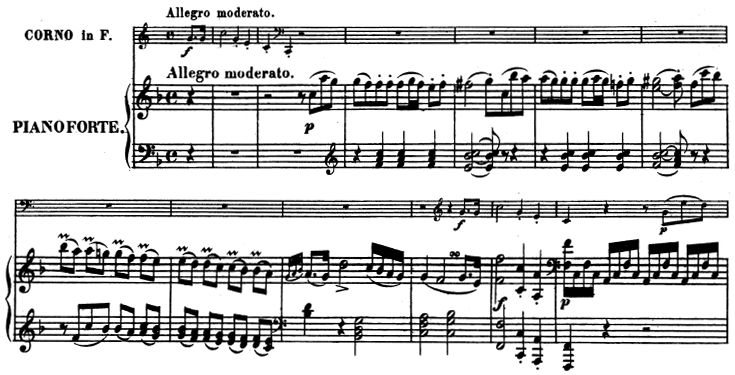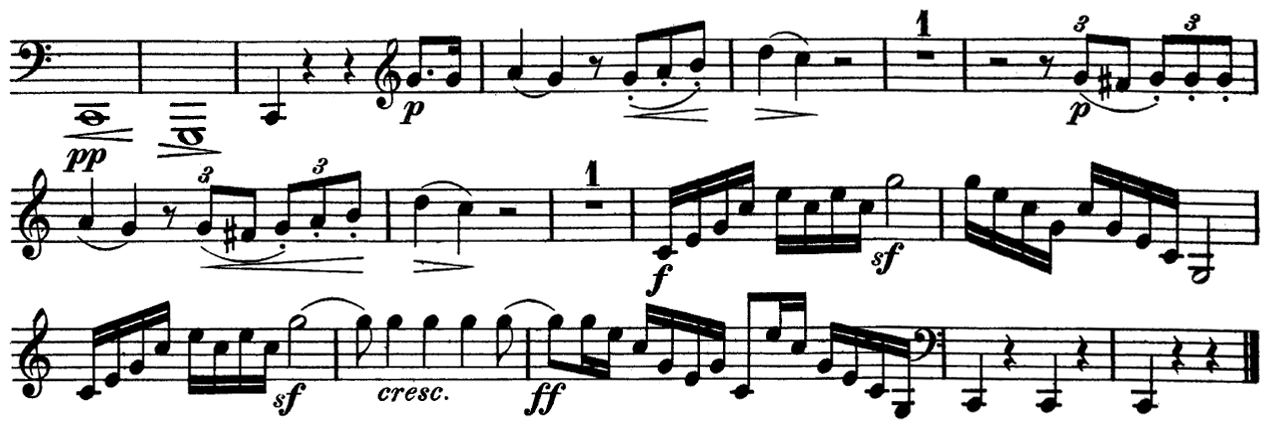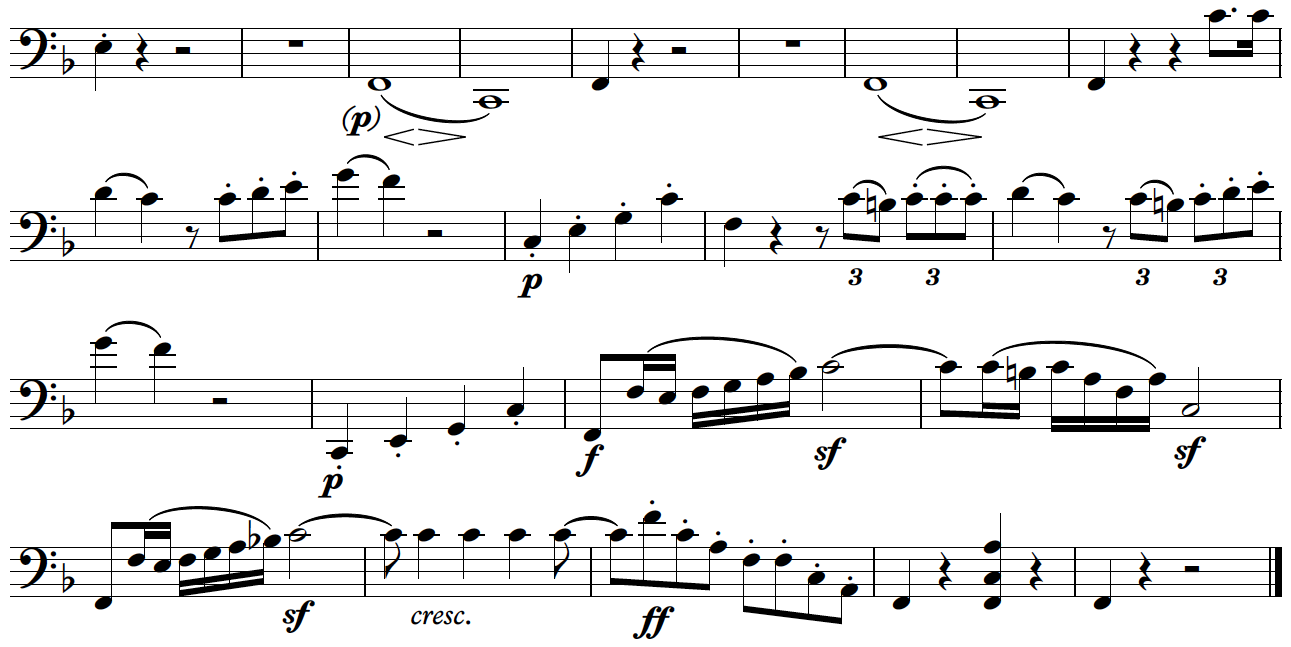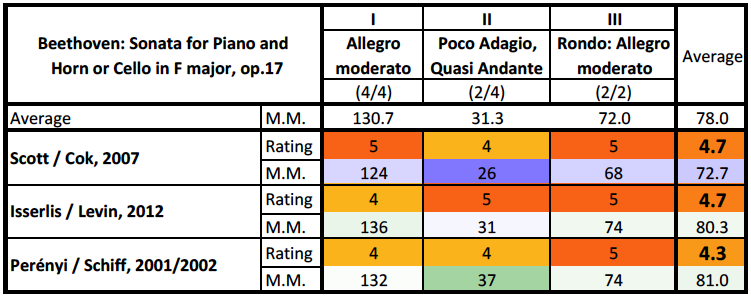Ludwig van Beethoven
Sonata for Piano and Horn or Cello in F major, op.17
Media Review / Comparison
2017-08-21 — Original posting
Table of Contents
Introduction
This is an extra posting on the recordings of Beethoven’s works for piano & cello in my music collection, about the Sonata in F major, op.17. References to the CDs are given in the respective section. See also the summary on the postings covering Beethoven’s Sonatas for Piano & Violoncello.
The Recordings
Below you find my comments on the recordings that I have for the Sonata for Piano and Horn or Cello in F major, op.17 (references to the recordings are given in each section). Here’s a short list of the recordings in this comparison, in alphabetic order (last name of the cellist):
- 2007: Anneke Scott (natural horn) & Kathryn Cok (fortepiano)
- 2012: Steven Isserlis (cello) & Robert Levin (fortepiano)
- 2001/2002: Miklós Perényi (cello) & András Schiff (piano)
Background, About the Instruments
Ludwig van Beethoven (1770 – 1827) wrote his Sonata for Piano and Horn or Cello in F major, op.17 in 1800, for one of the prominent horn virtuosi of the time, Giovanni Punto (1746 – 1803). The latter also premiered the sonata, with the composer at the piano. Given that the valve horn was not invented yet at the time, the technical demands in this sonata on the natural horn must have been very difficult to meet. Therefore, for the publication, Beethoven adapted the sonata to accommodate both the horn and the cello.
Cello vs. Horn
Of course, the idea of adding the cello version in order to broaden the scope, to amplify the sales of the sheet music is entirely understandable. The music must be published and sold, otherwise it may end up in a drawer and may ultimately be lost. However, in this case, the melodic texture is so obviously for the horn (or possibly other brass instruments) that the cello version doesn’t really stand a chance against the original version. However, the music still “lives” through Beethoven’s lively, playful and virtuosic piano part, which makes this still worthwhile playing also on the cello.
The horn part is clearly playable on the natural horn (see Anneke Scott‘s & Kathryn Cok‘s recording below). However, the technical challenges are substantial; plus, there aren’t that many musicians playing the natural horn.
Natural Horn vs. Valve Horn
I suspect that among the few horn recordings of this piece, most will be with the modern valve horn. Artists playing the modern valve horn may claim that they can play this sonata with much, much more balanced & controlled tone, with (almost) as much dynamic control as the cello, and with balanced, seamless sound color over the entire range. However, I think that this misses the point here: the valve horn was not invented when this sonata was written.
Beethoven must have thought of the natural horn. He certainly took into account the variation in volume and color caused by “left hand intonation”, i.e., creating the pith levels between the natural harmonics by inserting the left hand into the bell. This way of playing also modulates the volume and the sound color: the natural harmonics (no hand inserted) sound open, in the ff the instrument can blare like a hunting horn. When player inserts the left hand into the bell this alters the pitch and makes the tone softer, darker, more mellow.
The valve horn deprives the music of much of its vitality, the richness in colors. I didn’t even consider adding a valve horn version to my small collection.
Piano vs. Fortepiano
The melodic texture, the ornamentation really make this an ideal piece for the fortepiano, which offers the necessary flexibility and agility in the mechanics. On top of that, the modern concert grand lacks the fortepiano’s colors in the bass register, which the two recordings with fortepiano below expose so nicely. Once I heard the fortepiano in this part, I strongly prefer this instrument over the concert grand, for this piece.
As for the cello version: at least in concert, this composition strongly calls for a fortepiano, from the point-of-view of balance alone: unless the lid is closed, the rich piano part threatens to cover the cello part. In recordings, the sound engineer will usually correct the balance, in otder to circumvent this issue.
About the Composition
The Movements
Beethoven’s Sonata for Piano and Horn or Cello in F major, op.17 has three movements:
I. Allegro moderato (4/4)
The first bars already display the key features of this movement: the typical horn call, followed by a richly ornamented, lively piano segment. It’s a sonata movement, i.e., the exposition part is repeated.
II. Poco Adagio, quasi Andante (2/4)
The slow movement isn’t more than a short intermezzo (17 bars). The tricky part here is in the annotation: it’s in 2/4 time, and the tempo is Poco Adagio, quasi Andante. A quasi Andante in crotchets is out of question. At least on the horn, this would render the demisemiquavers in the horn part unplayable. On the cello, this may be possible, but the character of the music should certainly reflect the original instrument designation. The only viable option is, to read this as (poco) Adagio on the crotchets, aiming for a quasi Andante in the quavers (as if it were in 4/8 time). With this, the annotation makes sense:
III. Rondo: Allegro moderato (2/2)
The Rondo theme (couplet) features a typical horn call:
In contrast, the Intermezzi are initially showing lyrical cantilenas. Later-on, the horn part is brilliant and virtuosic, even featuring a (short) cadenza.
Horn vs. Cello in the Score
In order to adapt the horn sonata for cello, Beethoven didn’t just remove the transposition (for the horn in F), but he also adapted some passages, filled gaps with additional notes. Here’s the last part of horn part in the first movement:and the same section in the version for the cello (click for full size view):
The Interpretations, Overview
In order to provide a rating overview, as well as an idea about tempo relations both within an interpretation, as well as between the two recordings, I have prepared the table below. The color coding for the tempo (blue = slower, green = faster) refers to the average between the recordings:
Note that the metronome rates are approximate.
The Interpretations in Detail
With the exception of the first one, the recordings below are part of complete sets, covering all Beethoven cello sonatas, including all of the variation sets and the sonata op.17, discussed in this posting.
Anneke Scott and Kathryn Cok (2007)
Krufft: Sonata in E for horn and piano; Beethoven: Sonata in F for horn and piano, op.17;
Anonymous: Largo for horn and piano after the String quartet op.74/3 in G minor, Hob.III/74, “Rider quartett”, by Joseph Haydn;
Leidesdorf / Bellonci: Sonata in E♭ for horn and piano, op.164
Anneke Scott,natural horn; Kathryn Cok, fortepiano
Challenge classics CC72515 (CD, stereo); ℗ / © 2011

For details / general information on the artists and their instruments see my Listening Diary posting from 2013-09-30 covering compositions by Krufft, Beethoven, and Scriabin. Anneke Scott plays natural horn by Andreas Jungwirth (1997), after an instrument by Lausmann (ca. 1790). Kathryn Cok is playing on a fortepiano by David Winston (2007), a replica of an instrument by Michael Rosenberger (Vienna, ca. 1798).
This recording was my first CD encounter with the natural horn. And it fascinates me to this day! Anneke Scott must be one of the best & foremost natural horn players today. Her agility, the richness in colors, in dynamics, and in articulation are all astounding. And they make the cello version sound absolutely pale! And the fortepiano equally fascinates in this recording. Again, the richness in colors, especially in the bass, the singing, the agility in the rapid ornaments are astopunding. I find this fortepiano to be very close in characteristics to a Walter instrument!
I. Allegro moderato
Duration: 8’27”
Excellent playing, not only with the horn, but also on Kathryn Cok’s part: e.g.,m the way she makes those little “fiorituras” (e.g., in bar #21) bloom, her subtle, yet distinct agogics, her careful and detailed articulation. The beginning of the development part is switches to minor tonality. I think it’s a nice idea at this point, to take back the pace a bit, as the artists do here. With the return to major tonality a few bars later, the original tempo gradually returns.
II. Poco Adagio, quasi Andante
Duration: 1’27”
I would call the interpretation of this movement a “moderate mishap”: it’s definitely too slow, hence static: definitely not enough Andante or quasi Andante (a very slow funeral march at best!). Certainly, it is impossible to hear or feel the 2/4 time. At this slow pace (no, it’s not a limitation of the horn!), even some of the ornaments on the horn) feel clumsy.
III. Rondo: Allegro moderato
Duration: 5’08”
The tempo here is slightly slower than with the two cello recordings. Still it is appropriate for the horn and never feels slow. I like Anneke Scott’s short cadenza with its legato articulation (something which must be much harder to do with valves!).
| Duration: | 15’00” |
| Recommendation: | YES — Definitely recommended! |
| Rating: | 4.7 (5 / 4 / 5) |
Steven Isserlis and Robert Levin (2012)
Beethoven: The Sonatas for Cello & Piano, incl. op.17; Variations WoO 45, 46, op.66
Steven Isserlis & Robert Levin
hyperion CDA67981/2 (2 CDs, stereo); ℗ / © 2014
Booklet: 24 pp. e/f/d

For details / general information on the artists see my posting “Beethoven: Cello Sonata in A major, op.69“. Isserlis plays a cello by Stradivarius, “Marquis de Corberon”, from 1726, and a Tourte bow. Levin plays a fortepiano by Paul McNulty—a replica after an instrument by Walter & Sohn from around 1805.
I. Allegro moderato
Duration: 7’50”
One cannot (and should not) do a straight comparison of the horn version versus this one. Sure, Steven Isserlis aptly tries to imitate the horn calls at the beginning. However, in the subsequent cantilena he switches to “singing cello sonority” on the upper strings, and this is very far from what we hear from Anneke Scott’s horn. The sound balance is excellent: for classical music, a fortepiano is the far better match & complement to a cello than a modern concert grand. Isserlis resists the temptation to dominate (actually, I doubt that this would be in his nature anyway!), also explores p and pp.
The one quibble I have here is that the fortepiano tends to accelerate, particularly on the “weak” notes within a bar. This is done deliberately, as it occurs throughout the movement. Agogics within a bar is nothing I can object to (quite to the contrary!). But the way it occurs here gives me a feeling of rushing. Yes, it does make these notes appear lighter (probably the intent). However, to me it also feels slightly superficial. While that may seem to fit the character of the fortepiano as instrument, it hardly reflects Beethoven’s character as a virtuoso and pianist (for as much as we know, and what I take from his piano compositions in general).
II. Poco Adagio, quasi Andante
Duration: 1’19”
For my feeling, the best tempo in this movement among the three contenders: it feels like Andante on the quavers, and at the same time, the 2/4 time is still present. Excellent pp playing—Levin is using the moderator to make the fortepiano sound even softer, darker, more mellow.
III. Rondo: Allegro moderato
Duration: 5’05” (actually 4’45”)
Excellent agogics and articulation in general. Steven Isserlis keeps the cadenza simple (a simple, descending broken chord, simpler and shorter than Anneke Scott on the horn). The tempo is good, natural, with excellent agogics (only occasionally, I feel a light rushing). The one quibble I have is that in bar #4 of the theme (see the above score sample), in the pairs of quavers, the inverted mordents (Pralltriller) are all performed as turn, i.e., starting with an acciaccatura. In the first pair, this may be appropriate, as the preceding note is the same as the start of the first pair. However, the subsequent pairs start a tone below the last note, and there, the extra acciaccatura is incorrect, I think (in my opinion, it does not add any value here).
| Duration: | 14’13” |
| Recommendation: | Even though it misses out on some of the horn-specific features, this is an excellent recording—recommended! |
| Rating: | 4.7 (4 / 5 / 5) |
Miklós Perényi and András Schiff (2001/2002)
Beethoven: The Sonatas for Cello & Piano, incl. op.17; Variations WoO 45, 46, op.66
Miklós Perényi & András Schiff
ECM New Series 1819/20 (2 CDs, stereo); ℗ / © 2004
Booklet: 28 pp. d/e

For details / general information on the artists see my posting “Beethoven: Cello Sonata in A major, op.69“. No information on the instruments is given in the booklet, though one picture shows András Schiff playing a Steinway (D) grand.
I. Allegro moderato
Duration: 8’00”
András Schiff is excellent at detailed, careful articulation: he knows how to make the piano sing, and he does his utmost to keep the piano part clear, maybe even trying to approach the sonority of the fortepiano? The latter, however, must fail with the bass register: although I find Schiff’s bass line amazingly nice and sonorous, it remains a far cry from the colors of the fortepiano, especially in the segments with a lively bass line.
The cello is equally careful and detailed in the articulation, occasionally tending towards legato playing (broader than Schiff). At times, it sounds slightly dull, though—probably a sign of the dominance of the concert grand, which the sound engineer wasn’t able to correct completely.
II. Poco Adagio, quasi Andante
Duration: 1’09”
Here, the artists appear to have tried realizing a quasi Andante on the crotchets (2/4 time): it’s the fastest interpretation here. To me, this tempo doesn’t quite work out. Yes, one can feel the 2/4 time, but it still is too slow for an Andante on the crotchets. On the other hand, the pace (looking at the quavers) appears to be urging / pushed. This causes too much unrest in this short movement, which I think should also be a kind of resting pole in the sonata.
III. Rondo: Allegro moderato
Duration: 4’47”
Schiff once more excels with excellent, careful and detailed articulation, throughout the movement. Minor quibbles also here: for one, Schiff makes the broken octaves (semiquaver pairs) in the right hand (but not those in the bass) sound like acciaccaturas. Also, sadly, the artists just leave the fermata as is, where the other two recordings insert a short cadenza—a missed opportunity!
| Duration: | 13’54” |
| Recommendation: | This is probably about as good as it can get with a modern concert grand. I also think one can often sense the inappropriate dominance of a modern grand piano. However, if you don’t like the horn, and you can’t stand the sound of the fortepiano (you are missing something, then!), then this is certainly an excellent example for a recording on modern instruments, and recommended as such. |
| Rating: | 4.3 (4 / 4 / 5) |
Conclusions
My strong recommendation is that you should go for a recording with fortepiano. I definitely think that the recording with Anneke Scott & Kathryn Cok is worth a strong recommendation—see above. As the cello version is also by Beethoven, I would equally recommend the recording with Steven Isserlis & Robert Levin, even though for a cellist, this sonata must look fairly simple (maybe even boring or uninteresting?), compared to Beethoven’s “proper” sonatas for piano and cello, opp.5, 69, and 102.
If you can’t stand period instruments—fortepianos, in particular—then the recording with Miklós Perényi & András Schiff is certainly an excellent choice—even though it is far away from Beethoven’s original version. I have not tried / explored a version with modern valve horn (and then of course a modern piano). Personally, I’m not inclined even just to try this option: then, I find the version with cello (and ideally fortepiano) the more interesting alternative to a natural horn.














